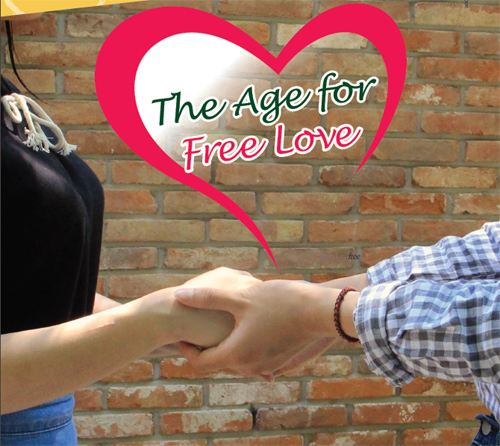
Dating in Korea has become common. With love always in the air, young couples indulge in more casual and liberal love relationships. It has not been long since singles could choose who to date, but like most young Koreans, more and more UOS students are already embracing free love.
What was dating like when we had no cell phones, Internet, or social networking? Back in the old days when none of these mediums existed, people really had to work to get to know someone. For university students in the late 1960s, a typical first date might require hours of talking while sipping coffee at a quiet bakery or at a music cafe where folk music could be heard live. Throughout history, and in many societies, there have been times when women were not allowed to choose their love partners. In Korea, as well, only since modernization and the arrival of foreign influences have women been able to express their opinions and desires for love in public or to their families. What we now call free love is a new concept in Korean culture.
The term free love has manifested itself in a variety of movements throughout history, as well, but with various implications. In the 19th century, it came to indicate freedom to choose a monogamous partner and to end a relationship at one’s will. With a growing interest in the rights of women and sexual minorities in the early 1900s, the concept of free love began to signify equality in love relationships. In the decades that followed, the concept evolved again to indicate a casual sex lifestyle for both men and women. As we can see from these interpretations of free love, the adjective free carries two meanings: liberal and equal. The term free love can be defined, on the one hand, as love that embodies personal liberty, and on the other hand, as love that acknowledges an equality between both sexes in a relationship.
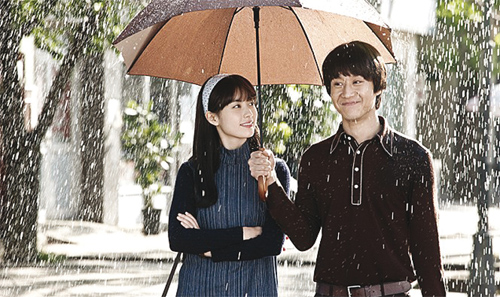
How have People Defined Love throughout History?
Classical Greek culture, which is often referred to as the cradle of western civilization, provides a range of words and definitions for love, many of which have influenced our values today. To the ancient Greeks, love was not a single concept, but six different concepts: eros, philia, ludus, agape, pragma, and philautia. Eros is translated as sexual passion, philia as deep friendship, ludus as affection between lovers, agape as selfless love, pragma as mature love, and philautia as self-love. In the east, commonly represented by classical Chinese culture and Confucianism, there is an emphasis on duty and circumstances in a relationship. Pronounced [ai], the Chinese character for love, 愛, consists of two different characters, one meaning “heart” and the other meaning “acceptance.” When combined into one pictogram, the two characters signify love. Such broad cultural difference in defining love leads us to another question: what is the Korean dating style, if such a style can be defined, especially for a people whose traditions have been so deeply immersed in the Eastern view of love?
As with most aspects of society in Korea, dating is definitely undergoing a change. Young Korean couples, in particular, have adopted a new dating style known as sseom. Imported from the English word, something, sseom refers to the period just before an actual relationship when two people have “something” going on. Although there are various definitions for the condition of sseom, it is commonly known as a prelude to a committed relationship in which people determine if dating would be worth their time and money, and possibly a permanent match.
Liberating the Dating Culture

by The UOS Times [ 182 Respondents ]
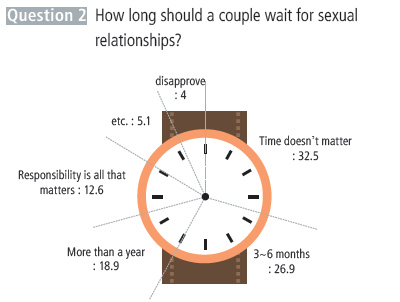
Different Perceptions on Dating
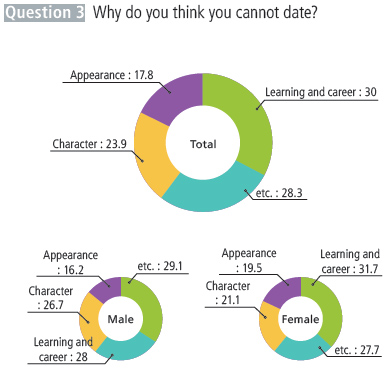
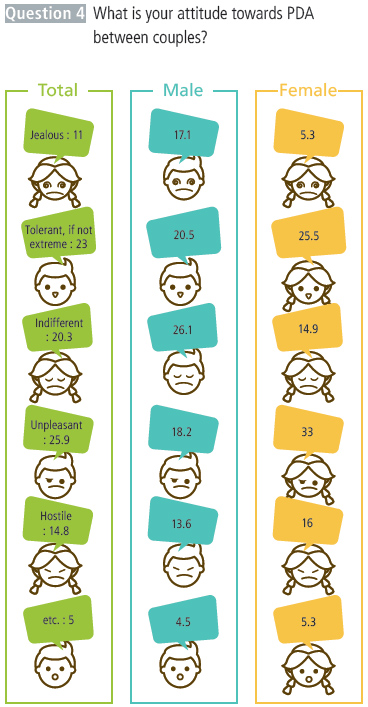
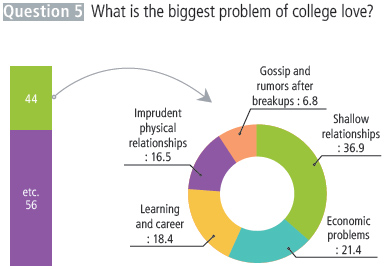
Unequal Dating
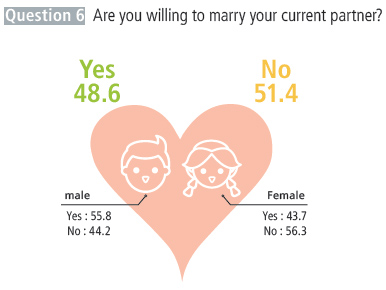
Female students were more reluctant when it came to marriage. Among male students, 55.8 percent replied that they would marry their current partners, while the percentage of female students who answered the same was lower by more than 10 percent: 43.8 percent. These results may reflect how women define the concept of marriage, and there may be several reasons why women are less interested in marrying. Although Korean society is becoming more liberal, Confucianism seems to have a strong influence with its formulation of unequal roles between man and woman; there are still some remnants of this discrimination these days. In Korea, women have often encountered glass ceilings in their careers because of their conflicting roles as homemakers and mothers. In this environment, marriage and pregnancy seem to be obstacles only to female workers.
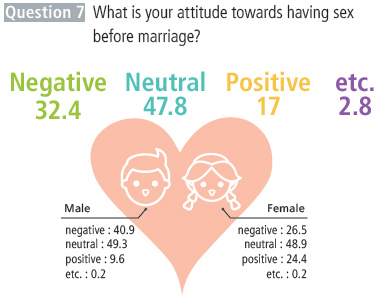
It is interesting to note that some female students expressed a distaste for the word virginity. They argued that, in Korean, the term virginity is only ascribed to women, and they recommended the use of other words. For comparison, in English, the term may refer to anyone of either gender who has not had sexual intercourse, although it still most commonly refers to women. This new view of virginity may reflect two concepts now gaining acceptance among young Koreans in general. First, it would be an error to define virginity as a biological condition; if applied to both genders, it may carry a more cultural definition, as well. As a biological term, it refers to a condition before the breaking of a woman,s hymen; however, the hymen may be broken in other ways apart from sexual intercourse. This definition leads to another error: the belief that the condition of the hymen reflects a woman,s character. Secondly, females have become more aware that they are being viewed as passive sexual objects and have begun to secure self-determination on sexual issues.
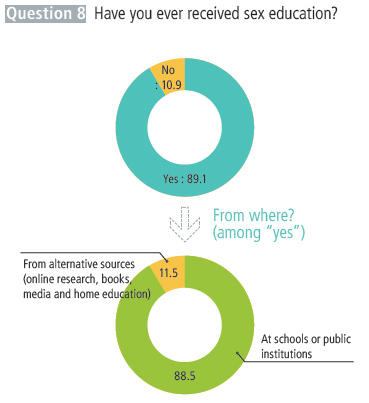
Unequal Reality Uncovered by UOS Students
Although survey results provide evidence that the general trend of dating is moving toward a more liberal approach to love, it is unclear whether the concept of free love also includes the ideal of equality. In responses to some questions, there remains a passivity on the part of women towards gender and sexual expression. On the question of whether to have sex before marriage, some female students told The UOS Times that “it feels like only women are forced to conform to such expectations,” and “forcing and expecting only women to not engage in premarital sex should be avoided.”
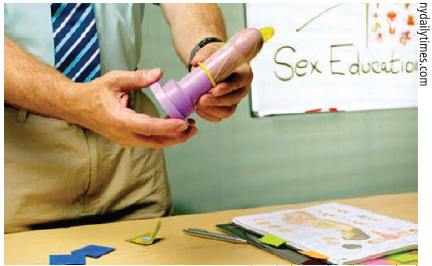
A lack of sex education may be a contributing factor to imprudent behaviors in physical relationships. Most UOS students surveyed appear to have received sex education before entering college. Still, 10.9 percent of students answered that they have not received it. Among those who stated that they had taken some sex education courses, a majority indicated that they had received their education from schools or public institutions. Only 11.5 percent cited alternative sources including online research, books, media and home education. The percentage of students who have received sex education is significantly high. However, issues such as unwanted pregnancy or sexual harassment among university students bring the adequacy of sex education into question. Sang-soo Kim, a counselor at the UOS Student Counseling Center, said that sex education in Korea concentrates on basic theories, without a concern for how those theories may be applied in real life. He also mentioned that college students are aware of the necessity of practical sex education, but they lack the opportunity.
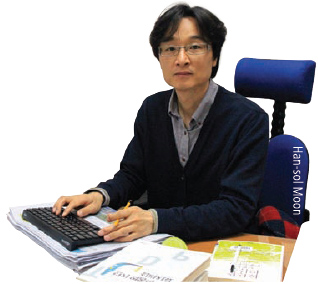
As it undertakes an improvement in sex education, UOS can learn from a precedent in 2014. In a bid to increase awareness among students of practical sexual knowledge, the Counseling Center held a “Healthy Sexual Culture Campaign,” which included a booth, where students could gain exposure to devices for sexual protection and pleasure and safely consider the implications of their own sexual activity. Not only through experience, but also through a change in social perception, students will be able to understand sexual relationships better. Korean society needs to shun a social atmosphere that regards sex as a taboo topic and a source of embarrassment.
As members of a rapidly changing society, we are experiencing a more liberal love culture. Things that were impossible in the previous century have become quite natural, and young Koreans have more freedom now to speak up for their thoughts and feelings. However, whether we are genuinely free remains in doubt. People cannot call themselves free when there is only license. Reports of dating violence and sexual harassment are among us and will endanger this free culture of love if they continue. Although society permits a more open mind toward love than ever before, it is also true that this is a more difficult time for university students to fall in love; it is highly competitive and fraught with confusion and uncertainty.
To counter the pressure, perhaps students should adopt an attitude that love is more precious - achieved through considerable effort by both men and women. Both sexes need to treat each other as equal human beings, with their own rights of self-determination. This right will become evident only through mutual respect. It is crucial, especially for women in their own progress, to remember that people are independent beings with active control over their own feelings and behaviors. If university students accept the ideal of autonomy and responsibility between both genders, our free love will not only be liberal, but also equal. As Kim pointed out, “Love is one of the important learning processes in life. Students learn how to form relationships with the other gender through their experiences with love in university.”
Sae-hee Jeong
saeheejeong1@uos.ac.kr
Han-sol Moon
alicemoon94@uos.ac.kr

